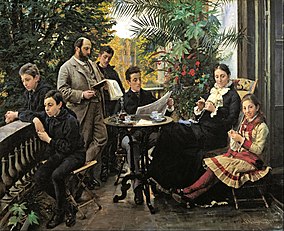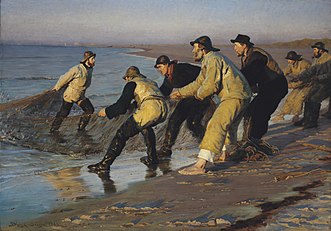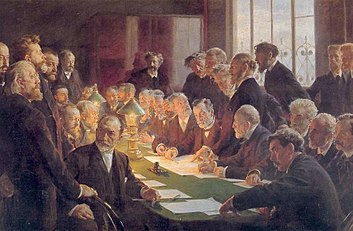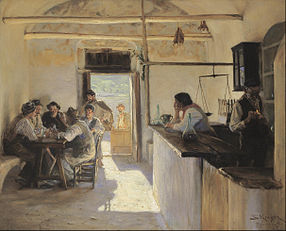She said to me "I want to go to Scandanavia " and although my response was ok lets go deep down , my heart sank .I didnt really fancy it. Why ?
For the reasons that Londoners never really leave London unless they have to. For instance, you can't find many from the Square Mile who have even been to Scotland. Proper Londoners dont see the fascination in going to places like Sweden and Norway and Denmark. But she was Italian so we went and it was a journey that in the end had a reason .
I found a great painter.
Journeying across Scandanavia was in the end fun . Its a place where you spend lots of money and dont think its gonna be good in the culinary stakes . Once I went into a fish place in Trondheim and they served fish fingers . But that said I did find Peder Severin Kroyer
At the end of the 19th century, Skagen was cut off from the rest of Denmark, as it was really hard to reach the town without the railway, so you had to take a horse from Frederikshavn and because there was no harbour, the ships had to sail further out on the west coast, despite the wild waves which made it dangerous to reach the land.
The old fishing village in Skagen inhabited about 2000 citizens who lived a simple and hard life. The fishing village is near Grenen, where Skagerrak and Kattegat meet and one of the most beautiful places of Denmark can be found here and one which inspired the artists to transform the world of art.
It is a village in the northernmost part of Denmark.
From the late 1870s until the turn of the century, a group of Scandinavian artists descended on Skagen every summer.
It was the light that drew them.
A translucent light that merged the sea and the sky—especially during the evening “blue hour”.Influenced by the “en plein air” techniques of French Impressionist painters like Claude Monet, they broke away from traditions taught at the academies and developed their own unique styles.
The long beaches stretched for miles and miles …
Cultural personalities like Steen Steensen Blicher, Vilhelm Kyhn and H. C. Andersen, all sought to visit the area around Skagen in the middel of the 19th century.
.Between 1877 and 1881, Krøyer travelled extensively in Europe, meeting artists, studying art, and developing his skills and outlook. He stayed in Paris and studied under Léon Bonnat, and undoubtedly came under the influence of contemporary impressionists – Claude Monet, Alfred Sisley, Edgar Degas, Pierre-Auguste Renoir and Édouard Manet.
He continued to travel throughout his life, constantly drawing inspiration from foreign artists and cultures. Hirschsprung provided financial support during the early travels, and Krøyer continued exhibiting in Denmark throughout this period.
On a trip to Paris in 1888 he encountered Marie Martha Mathilde Triepcke, whom he had known in Copenhagen. They fell in love and, after a whirlwind romance, married on 23 July 1889 at her parents' home in Germany. Marie Krøyer, who was also a painter and became associated with the Skagen community, and after their marriage was often featured in Krøyer's paintings. The couple had one child, a daughter named Vibeke, born in January 1895. They were divorced in 1905 following a prolonged separation.
Krøyer's eyesight failed him gradually over the last ten years of his life until he was totally blind. Ever the optimist, he painted almost to the end, in spite of health obstacles. In fact, he painted some of his last masterpieces while half-blind, joking that the eyesight in his one working eye had become better with the loss of the other eye.
Krøyer died in 1909 in Skagen at 58 years of age after years of declining health. He had also been in and out of hospitals, suffering from bouts of mental illness.
Krøyer's best known and best-loved work is entitled Summer Evening on Skagen's Southern Beach . He painted many beach scenes featuring both recreation life on the beach (bathers, strollers), and local fishermen.
Another popular work is Midsummer Eve Bonfire on Skagen Beach (Sankthansbål på Skagen strand), 1906. This large-scale work features a great crowd of the artistic and influential Skagen community gathered around a large bonfire on the beach on Saint John's Eve (Midsummer Eve).
Both of these works are in the permanent collection of the Skagens Museum which is dedicated to that community of artists, including those who gathered around Krøyer, a great organizer and bon vivant.
1.Who influenced Pedar
2-Where did he meet his future wife
3. What kind of painting did he do ?
4- What do you think about this painting?








No comments:
Post a Comment